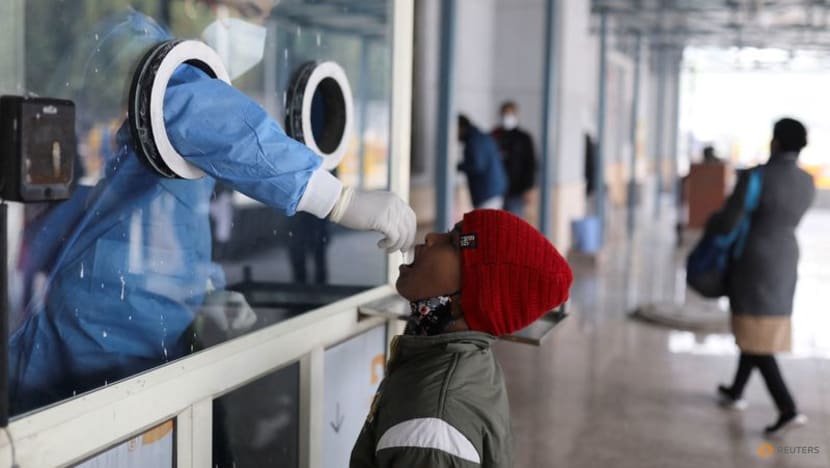New Omicron subvariant XBB.1.16: What you need to know about Arcturus
What is Arcturus and why did the World Health Organization describe the COVID-19 Omicron subvariant as "one to watch"?

FILE PHOTO: A healthcare worker collects a test swab sample from a child amidst the spread of COVID-19, at a testing centre inside a hospital in New Delhi, India, on Jan 14, 2022. (Photo: Reuters/Anushree Fadnavis)
SINGAPORE: India is experiencing a surge in COVID-19 cases, believed to be driven by the Omicron subvariant XBB.1.16 known as Arcturus.
Indian news outlet New Delhi Television reported on Thursday (Apr 13) that the country logged more than 10,000 new COVID-19 cases in the past 24 hours, 30 per cent more than the day before.
The World Health Organization (WHO) had earlier said it was monitoring the subvariant XBB.1.16.
Here's what you need to know about the new COVID-19 subvariant:
WHAT IS THE ARCTURUS SUBVARIANT?
The Arcturus – or XBB.1.16 - is a subvariant of the Omicron virus that WHO said it is monitoring “because it has potential changes that (it needs) to keep a good eye on”.
It was first detected in January, and added to WHO’s list of variants under monitoring on Mar 22.
It is a recombinant – or hybrid – variant from the BA.2.10.1 and BA.2.75, which are descendents from the Omicron variant BA.2.
There were about 800 sequences of the virus from 22 countries, said WHO during a press conference on Mar 29. Most of them were from India, where XBB.1.16 had replaced the other variants in circulation.
It is similar in profile to the XBB.1.5 variant but has an additional mutation in the spike protein, which in lab studies shows increase infectivity, as well as potential increased pathogenicity, which refers to the ability of an organism to cause disease.
A study from the University of Tokyo showed that the variant spreads about 1.17 to 1.27 times more efficiently than the XBB.1 and XBB.1.5 strains, and suggested that it has the potential to spread worldwide in the near future.
Test results from the university also suggest that the variant is “robustly resistant” to a variety of COVID-19 antibodies.
“This is one to watch,” Dr Maria van Kerkhove, WHO’s technical lead on COVID-19, said in a press conference on Mar 29. “It has been in circulation for a few months.”
Dr van Kerkhove added that the organisation has not seen a change in severity among individuals or in populations, but noted that “we have to remain vigilant”.
WHERE HAS IT BEEN FOUND?
The Arcturus subvariant has been detected in more than 20 other countries, including Singapore, India, Nepal, the United States, Australia and the United Kingdom.
Most of the cases are reported in Nepal and India, which saw a jump in the number of infections in recent weeks.
In Singapore, the Ministry of Health said the current wave of COVID-19 infections is driven by a mix of XBB subvariants, including XBB.1.5, XBB.1.9 and XBB.1.16.
However, it added that there is currently no evidence of increased severity in the cases.
In the final week of March, 28,410 COVID-19 cases were recorded in Singapore, almost double the previous week's figure of 14,467.
WHAT ARE THE SYMPTOMS AND ARE VACCINES EFFECTIVE AGAINST IT?
According to New Delhi Television, those infected with the Arcturus variant can have symptoms such as sore throat, runny nose, fever, fatigue, cough, headaches, muscle pain and abdominal discomfort.
Many patients also reported itchy eyes and conjunctivitis, symptoms not seen in previous COVID-19 waves.
WHO said reports so far do not indicate a rise in hospitalisations, ICU admissions or deaths due to XBB.1.16.
Dr Rajendram Rajnarayanan, assistant dean of research and associate professor at the New York Institute of Technology, was quoted by Fortune as saying booster vaccines targeting the Omicron strains should offer “some protection if the dose is recent”.
However, he also noted that the virus has continued to evolve since the vaccines were released last year.
WHAT IS THE SITUATION IN INDIA?
On Thursday, India reported 10,158 new cases - a 30 per cent jump from the 7,830 cases reported the previous day - with surges in Maharashtra and Delhi, the country's ABP news outlet said.
This brought the number of active cases to 44,998.
Health officials said the country's COVID-19 situation is moving towards the endemic stage and that infections may keep rising for the next 10 to 12 days, following which they will subside.
Hospitalisations are low and expected to remain that way, despite the rise in cases, they added.
The Arcturus subvariant's prevalence increased from 21.6 per cent in February to 35.8 per cent in March, but no incident of hospitalisation or death has been reported.
A nationwide mock drill to evaluate hospital preparedness was held earlier this week amid the increase in cases, with as many as 36,592 public and private facilities taking part.

















